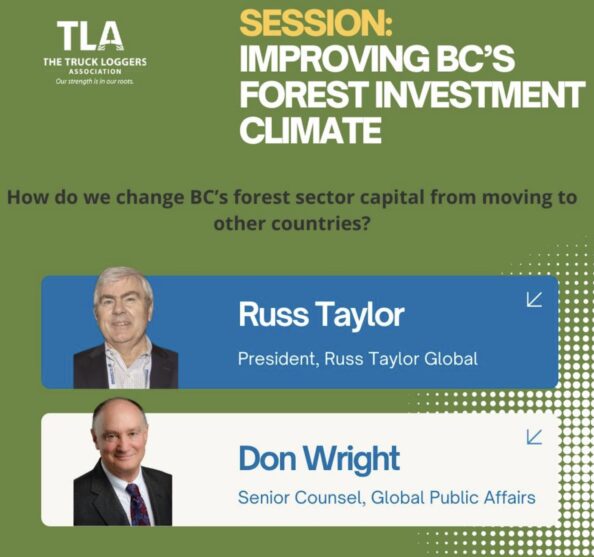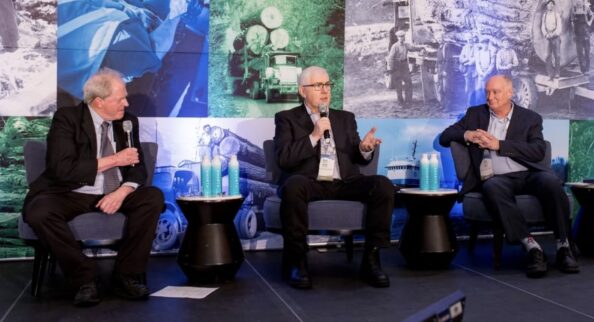
On Day 1 of the Truck Loggers Association 80th Annual Convention in British Columbia, experts Russ Taylor and Don Wright shared their perspectives on why investment capital is leaving BC’s forest sector and what can be done to reverse the trend. Moderated by Vaughn Palmer, Vancouver Sun political columnist, the session tackled the central theme: How do we change BC’s forest sector capital from moving to other countries?
Diagnosing the Decline — Russ Taylor, President of Russ Taylor Global and an experienced wood business consultant, opened the discussion by presenting a sobering analysis of BC’s forest sector. Taylor detailed the compounding challenges: reduced timber supply, government policies, and an outdated stumpage system that exacerbates costs and reduces competitiveness.
Taylor traced the decline back to structural changes over the past two decades, including the mountain pine beetle epidemic, increasing forest fires, and shifts in policy favoring conservation over industrial expansion. He noted that since 1990, BC has seen a one-third reduction in its Annual Allowable Cut (AAC) and a 50% drop in lumber production from both small and large operations. The consequences have been devastating for both the forest sector and the communities dependent on it.
One striking example is the mismatch between policy-driven reductions in timber supply and the realities faced by sawmills. Many sawmills in BC are operating below the 80% capacity required for profitability. Taylor explained that while the US South attracts investment with ample timber, low costs, and close proximity to markets, BC’s regulatory environment and logistical challenges discourage new ventures.
Taylor also identified a pressing need to address inefficiencies in cutting permits and the stumpage formula. The lag in adjusting stumpage rates to market conditions creates an imbalance, forcing sawmills to curtail production during price fluctuations. “We don’t have the wood supply to get our mills running efficiently,” he emphasized, warning that without reforms, BC will continue to lose ground to more competitive regions.
Taylor concluded by urging stakeholders to collaborate with the government to create policies that encourage investment, streamline processes, and improve competitiveness. His message was clear: BC must adapt or risk further decline.

Understanding Government Decision-Making — Don Wright, Senior Counsel at Global Public Affairs and former Deputy Minister to the Premier of BC, offered a broader perspective, focusing on the complexities of government decision-making and how economic priorities evolve. Wright’s insights complemented Taylor’s data-driven approach by providing context for why policy change can be so difficult to achieve.
Wright began by highlighting a critical difference between governments and corporations. “Governments operate in a world of loosely controlled chaos,” he explained. Unlike corporations, which have clear hierarchies and profit-driven goals, governments are influenced by a web of actors, including ministers, backbenchers, independent offices, and opposition parties. This fragmented structure often leads to inconsistent policies and shifting priorities.
He argued that governments typically learn through crises. “All governments come to office full of vim and vigor, convinced they will do better than their predecessors,” Wright said. However, the realities of governance—including competing demands, limited resources, and unforeseen crises—often temper those ambitions.
Wright pointed to the current BC government’s experience as a case study. Coming to power in 2017 with little direct experience in profit-and-loss management, the government initially focused on social equity, reconciliation with First Nations, and environmental priorities. These goals were achievable in the short term because the economy was strong, with low unemployment and high commodity prices providing a buffer.
However, the COVID-19 pandemic and subsequent economic disruptions revealed underlying vulnerabilities. Wright noted concerning trends, such as stagnant private sector job growth alongside significant public sector expansion. This imbalance, he warned, could lead to unsustainable fiscal pressures, requiring either higher taxes, increased debt, or major budget cuts.
Wright emphasized the importance of sustained advocacy to influence government policy. He called on forest sector stakeholders to unite with unions, First Nations, and communities to present a cohesive message. “Policy change doesn’t come from one meeting; it’s the persuasion of a thousand small steps,” he explained, urging industry players to engage with decision-makers at all levels.
The Path Forward: A Shared Responsibility — Taylor and Wright’s messages converged on the urgent need for collaboration and coordinated advocacy to improve BC’s forest investment climate. Taylor’s data painted a picture of an industry grappling with operational inefficiencies and competitive disadvantages. Wright’s analysis explained why addressing these issues requires persistence and strategic engagement with government.
The speakers agreed that reversing the current trajectory will take collective effort. Forest sector stakeholders must not only address immediate challenges, such as cutting permits and stumpage reform, but also work to build long-term partnerships with government and other stakeholders. The goal: to create a stable, competitive environment that attracts investment and supports sustainable growth.
Wright’s final call to action summed up the panel’s central theme: “Now is the time to get organized. Lock arms with other parts of the private sector, with private sector unions, with First Nations, and with local communities. Together, we can start doing the economic tutorials that government needs to hear.”